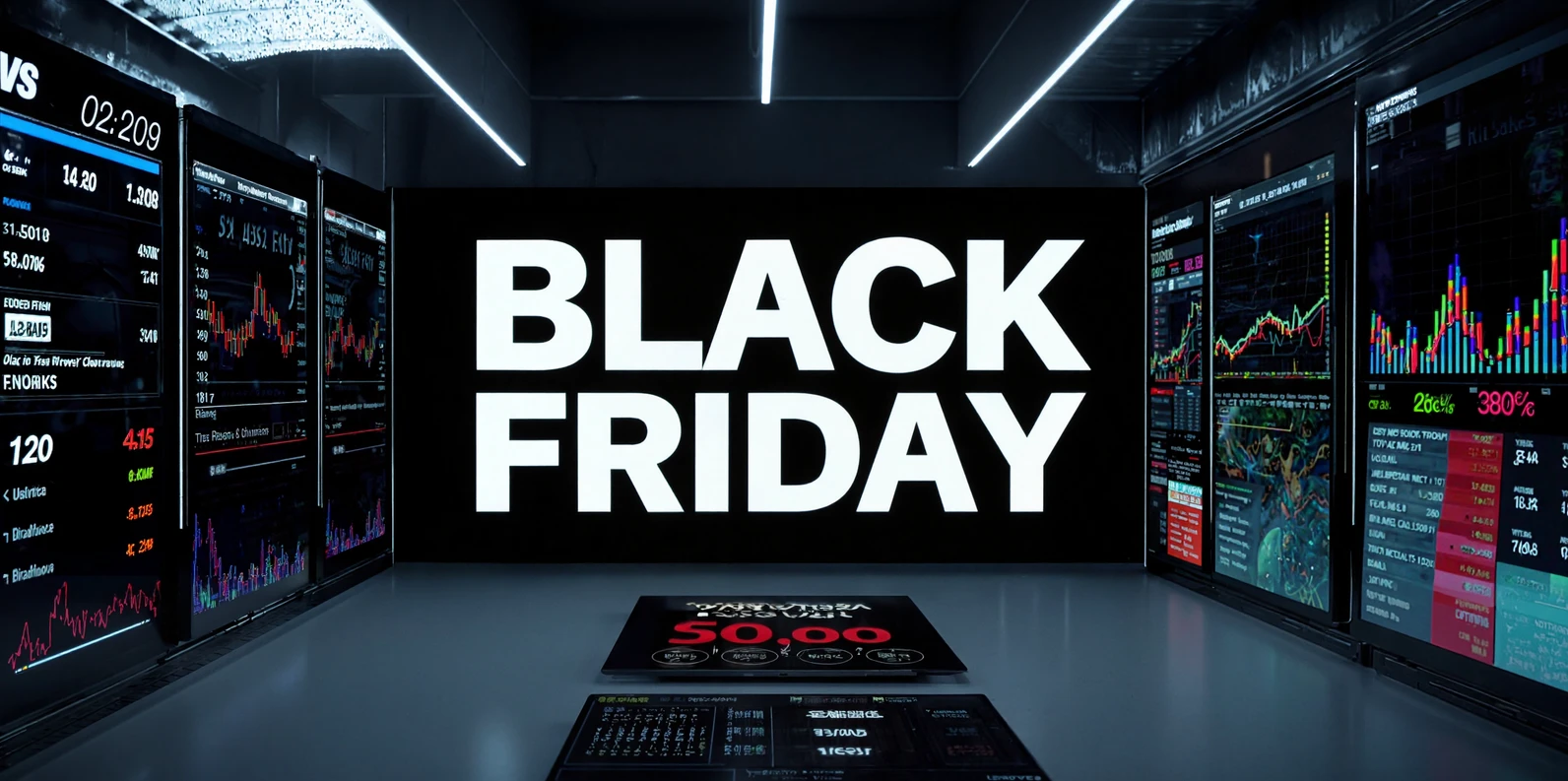Black Friday without the stomachache — problems to anticipate and how to avoid them

Black Friday isn’t “more of the same.” It demands real-time price/promo/stock, idempotent orders, queues in front of sluggish systems, a hardened perimeter, and observability at every step.
Black Friday is approaching
Black Friday exposes weaknesses in integrations. What “works okay” day-to-day breaks when traffic and change rates peak. Below are the most common problems—and how to design them away with a platform in Azure instead of point-to-point connections.
1. Promo prices stuck in batch jobs
When prices must flip at 00:00, a “nightly batch” is too slow. Feeds update late, caches serve stale content, and Google/marketplaces display wrong prices.
Example
-
00:00 – the price is lowered in the ERP
-
00:02 – customers search for the product
-
08:00 – Merchant Center/channels have caught up—eight hours too late
Your competitor already captured the night’s traffic.
Practical solution
-
Publish price/promo as real-time events via a queue (e.g., Service Bus), not as a nightly export.
-
Set freshness SLOs for price/promo (e.g., ≤ 60s end-to-end) and alert on breaches.
-
Use feature flags for exact 00:00 activation, plus a canary (1–5% of traffic) a few minutes before the full release.
2. When inventory lies—oversell and returns
Large inflow + slow stock reconciliation = a customer can place an order for an out-of-stock item.
Example
A product with 100 in stock sells 120 units in the first 30 minutes. Inventory update latency is > 5 minutes. Twenty customers get backorders/denials.
Practical solution
-
Emit a stock event on every change—avoid “poll every 5 minutes.”
-
Use a reservation or quota model in checkout (hard or soft reservations) for hot items.
-
Define an SLO for stock sync (e.g., ≤ 30s) and apply backpressure if the ERP can’t keep up.
3. Duplicate orders and webhook storms
At peak, users double-click, the payment provider retries, and marketplaces send the same webhook multiple times.
Example
Checkout times out, the customer clicks again, the PSP retries—three calls create three ERP orders.
Practical solution
-
Introduce an idempotency key per order (stored in the platform). Same key = one order.
-
Put an API perimeter (API Management) in front that enforces a signature, time window, and idempotency header.
-
Handle retries via dead-lettering and exponential backoff with jitter in the queue layer.
4. ERP bottlenecks—when the system can’t keep up
Direct calls against the ERP hit the ceiling (rate limits/CPU). Without queues, calls are lost or checkout blocks.
Example
ERP tolerates 100 req/min; the peak needs 800 req/min. Direct integration times out → orders/exports drop.
Practical solution
-
Decouple with a queue (Service Bus). Accept at the platform’s pace; process at the ERP’s pace.
-
Scale workers (Functions) to drain the backlog after peak—meet the SLA on average.
-
Enable brownout mode: park non-critical flows; prioritize the order flow.
5. Edge performance—gateway, cache, and protection
Without a clear edge, both legitimate spikes and attacks become dangerous.
Example
A sudden traffic spike causes random 429/500s; errors pass straight through to the backend.
Practical solution
-
Use API Management + Front Door/WAF to control rate limits, geo/IP policies, and mTLS where needed.
-
Cache safe read paths (e.g., static attributes) and keep the write path strict and idempotent.
-
Build a capacity model: load test at least 3× weekday traffic before Black Friday.
6. Observability—from “it doesn’t work” to root cause
Without correlation you won’t know which step failed.
Example
“Order export down” turns out to be a new partner payload missing an attribute.
Practical solution
-
Carry a correlation ID through the entire chain (APIM → Functions → Service Bus → ERP).
-
Build dashboards for three SLOs: Order latency, Price/Promo freshness, Stock freshness.
-
Alert on dead letters, signature errors, unusual retry frequency, and spikes in 429s.
7. Changes near peak—without breaking things
Last-minute changes can tip the entire system.
Example
A new promo rule is rolled out broadly at 21:00—PR missed a negative edge case.
Practical solution
-
Use feature flags + canary (1–5–20–100%) with automatic rollback on alerts.
-
Enforce a “change freeze” on non-critical parts seven days before Black Friday.
-
Treat configuration as code with mandatory contract tests on partner payloads.
8. Security under peak
Pressure increases—not only from customers.
Example
Leaked SAS keys or open function endpoints enable scraping/DoS—right when you’re most vulnerable.
Practical solution
-
Use Managed Identity everywhere, Key Vault with rotation, and private endpoints.
-
APIM policies: signature validation, IP/geo filters, DDoS protection, and bot rules.
-
Restrict SAS: time-bound, IP-locked, least privilege.
Three mini-cases (real outcomes)
-
00:00 promo: Switched from batch to event-driven price feed + flag-controlled activation. Freshness dropped from ~4h to < 60s. First-hour revenue +14% YoY.
-
ERP bottleneck: Introduced queue + workers, prioritized orders over secondary flows. 0% order loss; backlog cleared 17 minutes after peak.
-
Duplicate orders: Idempotency key + APIM signatures. Duplicates down 99.8%; support tickets per 1,000 orders halved.
Black Friday playbook (short and concrete)
-
Set SLOs: Order ≤ X seconds, Price/Promo freshness ≤ Y seconds, Stock freshness ≤ Z seconds.
-
Test: Load 3× weekday; inject chaos on ERP timeouts and PSP retries.
-
Protect the edge: APIM rate limits, signatures, WAF/bot protection.
-
Make it robust: Idempotency, queues, backoff + jitter, brownout mode.
-
Control change: Feature flags, canary, change freeze on non-critical parts.
-
Measure & alert: Correlation IDs, SLO dashboards, alerts on dead letters/429s/signature errors.
Conclusion
Black Friday isn’t “more of the same.” It requires real-time price/promo/stock, idempotent orders, queues in front of slow systems, a hardened perimeter, and measurement at every step.
Build this as a platform in Azure—instead of point-to-point—and you stay in control when it matters most: more conversions, fewer incidents, and a calmer night between 00:00 and 08:00.
Want to start simple? Take the price/promo flow, set a freshness SLO, build the event path, measure before/after—and roll forward from there.
More reading
More blogs
All blogs
Agentic Commerce reshapes commerce so only companies with stable, traceable information flows stay visible in customers’ agent-driven journeys
Read more
Serverless Azure integrations: manage rules as config, launch flows without code and boost AI visibility while cutting order costs.
Read more
Full-time assignment as a full-stack developer where you own features from UI to API. Secure data-sharing portal, measurable impact and long-term product development.
Read more